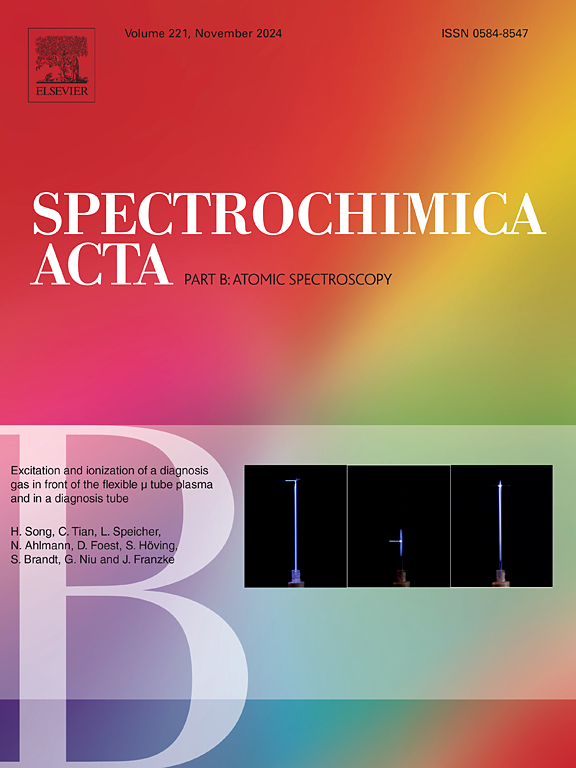Rapid detection of total chromium in water bodies using AuAgPd trimetallic nanoparticles-modified filter paper combined with laser-induced breakdown spectroscopy
IF 3.8
2区 化学
Q1 SPECTROSCOPY
引用次数: 0
Abstract
Heavy metal contamination in water bodies poses a severe threat to ecosystems and human health, thereby necessitating the development of rapid and highly sensitive detection methods. Traditional laboratory detection techniques are limited in their widespread application due to expensive equipment and complex operational procedures. To address this issue, we developed a rapid detection technique based on AuAgPd trimetallic nanoparticles(TNPs)-modified filter paper combined with laser-induced breakdown spectroscopy (LIBS) for the determination of total chromium (Cr) in water. AuAgPdTNPs-modified filter paper efficiently enriches Cr of different valence states, while LIBS quantifies total Cr from its characteristic emission lines. Experimental results demonstrate that the limit of detection (LOD) of total Cr is 0.21 μg/L (4 nM), showing good linearity in the ranges of 0–50 μg/L and 50–1000 μg/L. In tests with actual water samples, the method showed high reliability, with recovery rates ranging from 95.24 % to 106.15 %. This technology provides a novel solution for the rapid detection of heavy metal pollution in water bodies and holds broad application prospects.

AuAgPd三金属纳米颗粒修饰滤纸结合激光诱导击穿光谱法快速检测水体中总铬
水体重金属污染对生态系统和人类健康构成严重威胁,因此有必要开发快速、高灵敏度的检测方法。传统的实验室检测技术由于设备昂贵和操作程序复杂,限制了其广泛应用。为了解决这一问题,我们开发了一种基于AuAgPd三金属纳米颗粒(TNPs)修饰滤纸结合激光诱导击穿光谱(LIBS)的快速检测技术,用于水中总铬(Cr)的测定。auagpdtnps改性滤纸能有效富集不同价态的Cr,而LIBS则通过其特征发射谱线来定量总Cr。实验结果表明,总铬的检出限(LOD)为0.21 μg/L (4 nM),在0 ~ 50 μg/L和50 ~ 1000 μg/L范围内线性良好。在实际水样试验中,该方法具有较高的可靠性,回收率为95.24% ~ 106.15%。该技术为水体重金属污染的快速检测提供了新的解决方案,具有广阔的应用前景。
本文章由计算机程序翻译,如有差异,请以英文原文为准。
求助全文
约1分钟内获得全文
求助全文
来源期刊
CiteScore
6.10
自引率
12.10%
发文量
173
审稿时长
81 days
期刊介绍:
Spectrochimica Acta Part B: Atomic Spectroscopy, is intended for the rapid publication of both original work and reviews in the following fields:
Atomic Emission (AES), Atomic Absorption (AAS) and Atomic Fluorescence (AFS) spectroscopy;
Mass Spectrometry (MS) for inorganic analysis covering Spark Source (SS-MS), Inductively Coupled Plasma (ICP-MS), Glow Discharge (GD-MS), and Secondary Ion Mass Spectrometry (SIMS).
Laser induced atomic spectroscopy for inorganic analysis, including non-linear optical laser spectroscopy, covering Laser Enhanced Ionization (LEI), Laser Induced Fluorescence (LIF), Resonance Ionization Spectroscopy (RIS) and Resonance Ionization Mass Spectrometry (RIMS); Laser Induced Breakdown Spectroscopy (LIBS); Cavity Ringdown Spectroscopy (CRDS), Laser Ablation Inductively Coupled Plasma Atomic Emission Spectroscopy (LA-ICP-AES) and Laser Ablation Inductively Coupled Plasma Mass Spectrometry (LA-ICP-MS).
X-ray spectrometry, X-ray Optics and Microanalysis, including X-ray fluorescence spectrometry (XRF) and related techniques, in particular Total-reflection X-ray Fluorescence Spectrometry (TXRF), and Synchrotron Radiation-excited Total reflection XRF (SR-TXRF).
Manuscripts dealing with (i) fundamentals, (ii) methodology development, (iii)instrumentation, and (iv) applications, can be submitted for publication.

 求助内容:
求助内容: 应助结果提醒方式:
应助结果提醒方式:


